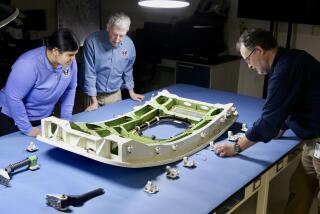Component of Doomed Plane Barely Met Standard
- Share via
Wear measurements cited by a mechanic who recommended replacement of a part suspected in the crash of an Alaska Airlines jet were barely within acceptable tolerances, repair manuals released by the carrier showed Tuesday.
John Liotine, who suggested the replacement, is the same mechanic whose allegations of falsified repair records led to an ongoing federal investigation that began at Alaska’s repair facility in Oakland in 1998.
In September 1997, Liotine was assigned to work on the MD-83 that would crash 28 months later. According to the airline, he measured the play in the horizontal stabilizer jackscrew mechanism at .040 of an inch. Concerned about the wear, Liotine ordered that the jackscrew be replaced, the mechanic said during a “Dateline NBC” interview that was aired Tuesday night.
The stabilizer is the large, winglike part of the plane’s tail that largely controls the up-and-down pitch of the nose. The jackscrew is a large, threaded bolt that moves through a gimbal nut, raising and lowering the leading edge of the stabilizer.
Based on remeasurements of the MD-83 in question, other mechanics later decided to leave the jackscrew on the plane. The manuals indicate that if Liotine’s measurements were correct, they met standards--but with no room to spare.
The MD-80 series maintenance manual requires the mechanic to “check that end play limits are between .003 and .040 inch. Readings in excess of above are cause for replacement of acme jackscrew and nut.”
Lou Cancelmi, a spokesman for the airline, said “the most important point remains that a jackscrew end play measurement of .040 of an inch was within accepted tolerances prescribed by the aircraft manufacturer and approved by the Federal Aviation Administration.”
Liotine could not be reached by The Times for comment.
FAA officials, who spoke on condition of anonymity, said such tolerances--determined after careful study--are set well short of the failure point and are presumed to provide an adequate margin of safety. Since the crash, the tolerances have been tightened slightly.
The cockpit crew of Alaska’s Flight 261 reported problems with the horizontal stabilizer of the MD-83 before the Jan. 31 crash off the Ventura County coast, which killed all 88 people on board.
The National Transportation Safety Board said after recovering wreckage that the nut’s threads were stripped and that no lubricating grease was found on the portion of the jackscrew that normally comes into contact with the nut. The cause of the crash remains under investigation.
Federal officials interviewed for a May 20 article in The Times provided incorrect figures for the end play measured by Alaska mechanics and the tolerances that determine jackscrew reinspection schedules.
More to Read
Sign up for Essential California
The most important California stories and recommendations in your inbox every morning.
You may occasionally receive promotional content from the Los Angeles Times.













